Red List assessment of amphibian species of Ecuador: A multidimensional approach for their conservation
- PMID: 33956885
- PMCID: PMC8101765
- DOI: 10.1371/journal.pone.0251027
Red List assessment of amphibian species of Ecuador: A multidimensional approach for their conservation
Abstract
Ecuador is one of the most biodiverse countries in the world, but faces severe pressures and threats to its natural ecosystems. Numerous species have declined and require to be objectively evaluated and quantified, as a step towards the development of conservation strategies. Herein, we present an updated National Red List Assessment for amphibian species of Ecuador, with one of the most detailed and complete coverages for any Ecuadorian taxonomic group to date. Based on standardized methodologies that integrate taxonomic work, spatial analyses, and ecological niche modeling, we assessed the extinction risk and identified the main threats for all Ecuadorian native amphibians (635 species), using the IUCN Red List Categories and Criteria. Our evaluation reveals that 57% (363 species) are categorized as Threatened, 12% (78 species) as Near Threatened, 4% (26 species) as Data Deficient, and 27% (168 species) as Least Concern. Our assessment almost doubles the number of threatened species in comparison with previous evaluations. In addition to habitat loss, the expansion of the agricultural/cattle raising frontier and other anthropogenic threats (roads, human settlements, and mining/oil activities) amplify the incidence of other pressures as relevant predictors of ecological integrity. Potential synergic effects with climate change and emergent diseases (apparently responsible for the sudden declines), had particular importance amongst the threats sustained by Ecuadorian amphibians. Most threatened species are distributed in montane forests and paramo habitats of the Andes, with nearly 10% of them occurring outside the National System of Protected Areas of the Ecuadorian government. Based on our results, we recommend the following actions: (i) An increase of the National System of Protected Areas to include threatened species. (ii) Supporting the ex/in-situ conservation programs to protect species considered like Critically Endangered and Endangered. (iii) Focalizing research efforts towards the description of new species, as well as species currently categorized as Data Deficient (DD) that may turn out to be threatened. The implementation of the described actions is challenging, but urgent, given the current conservation crisis faced by amphibians.
Conflict of interest statement
The authors have declared that no competing interests exist.
Figures
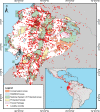
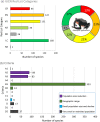
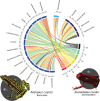
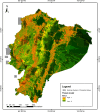

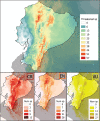
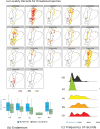



Similar articles
-
Patterns and biases of climate change threats in the IUCN Red List.Conserv Biol. 2018 Feb;32(1):135-147. doi: 10.1111/cobi.13022. Epub 2017 Oct 12. Conserv Biol. 2018. PMID: 28861903
-
Warning about conservation status of forest ecosystems in tropical Andes: National assessment based on IUCN criteria.PLoS One. 2020 Aug 25;15(8):e0237877. doi: 10.1371/journal.pone.0237877. eCollection 2020. PLoS One. 2020. PMID: 32841244 Free PMC article.
-
Remotely Sensed Data Informs Red List Evaluations and Conservation Priorities in Southeast Asia.PLoS One. 2016 Aug 3;11(8):e0160566. doi: 10.1371/journal.pone.0160566. eCollection 2016. PLoS One. 2016. PMID: 27487238 Free PMC article.
-
A practical guide to the application of the IUCN Red List of Ecosystems criteria.Philos Trans R Soc Lond B Biol Sci. 2015 Feb 19;370(1662):20140003. doi: 10.1098/rstb.2014.0003. Philos Trans R Soc Lond B Biol Sci. 2015. PMID: 25561664 Free PMC article. Review.
-
Developments in amphibian captive breeding and reintroduction programs.Conserv Biol. 2016 Apr;30(2):340-9. doi: 10.1111/cobi.12612. Epub 2015 Dec 2. Conserv Biol. 2016. PMID: 26306460 Review.
Cited by
-
Field-based molecular detection of Batrachochytrium dendrobatidis in critically endangered Atelopus toads and aquatic habitats in Ecuador.PLoS One. 2024 Mar 14;19(3):e0299246. doi: 10.1371/journal.pone.0299246. eCollection 2024. PLoS One. 2024. PMID: 38484016 Free PMC article.
-
Beyond the species name: an analysis of publication trends and biases in taxonomic descriptions of rainfrogs (Amphibia, Strabomantidae, Pristimantis).Zookeys. 2022 Dec 7;1134:73-100. doi: 10.3897/zookeys.1134.91348. eCollection 2022. Zookeys. 2022. PMID: 36761112 Free PMC article.
-
MALDI-TOF Mass Spectrometry Characterization of Culturable Microbiota Associated with the Skin of Amphibians from the Southern Andes Mountains of Ecuador.Microb Ecol. 2025 May 22;88(1):47. doi: 10.1007/s00248-025-02555-8. Microb Ecol. 2025. PMID: 40402178 Free PMC article.
-
Harrowing trends: how endangered-species researchers find hope in the dark.Nature. 2024 Jul;631(8020):467-469. doi: 10.1038/d41586-024-02205-y. Nature. 2024. PMID: 38977938 No abstract available.
-
Two new syntopic species of glassfrogs (Amphibia, Centrolenidae, Centrolene) from the southwestern Andes of Ecuador.PeerJ. 2023 May 9;11:e15195. doi: 10.7717/peerj.15195. eCollection 2023. PeerJ. 2023. PMID: 37187515 Free PMC article.
References
-
- IUCN. Guidelines for Using the IUCN Red List Categories and Criteria: Version 14. Standards and Petitions Subcommittee of the International Union for the Conservation of Nature.; 2019 [10/10/2020]. Available from: http://intranet.iucn.org/webfiles/doc/SSC/RedList/RedListGuidelines.pdf.
-
- Vasconcelos TS, da Silva FR, dos Santos TG, Prado VH, Provete DB. Biogeographic Patterns of South American Anurans. Switzerland: Springer International Publishing; 2019 2019. 149 p.
-
- Vitt LJ, Caldwell JP. Herpetology: An introductory biology of amphibians and reptiles. London: Academic Press; 2014. 757 p.
Publication types
MeSH terms
LinkOut - more resources
Full Text Sources
Other Literature Sources

